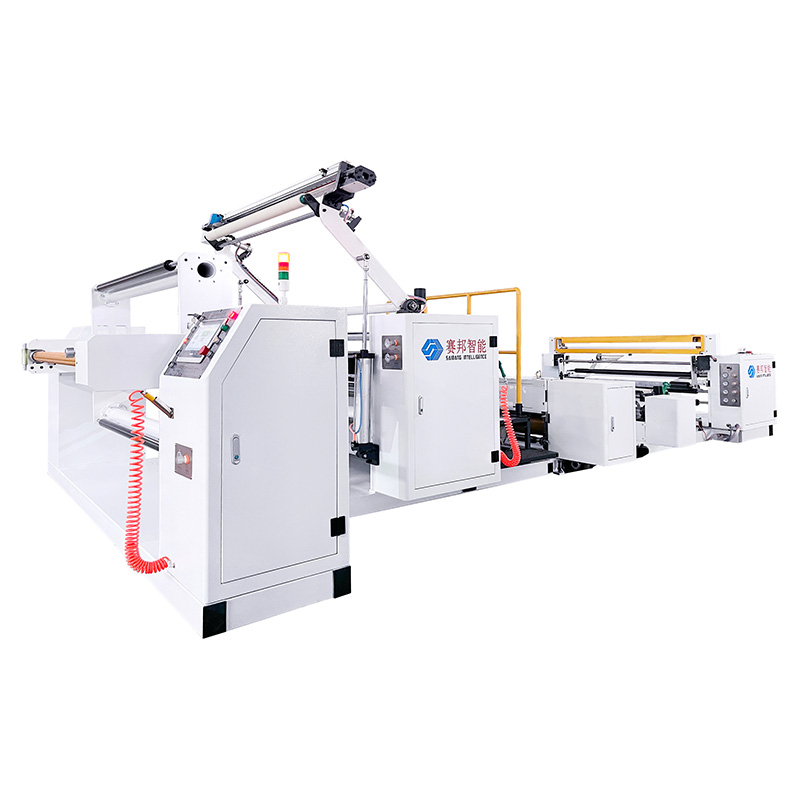How Does An Embossing Machine Work?
A non-woven Embossing Machine is an advanced piece of processing equipment designed to apply textures, patterns, and perforations onto non-woven materials. It integrates safety, precision, and intelligent control, ensuring high production efficiency and consistent pattern definition. The embossed and perforated non-woven fabric produced by this machine is widely used in diapers, sanitary napkins, wipes, and other hygiene or cleaning materials, enhancing both product appearance and performance.
1. Working Principle
The non-woven embossing machine operates through a combination of heat, pressure, and mechanical rolling, transferring the engraved texture from the roller surface onto the fabric.
During the process, a heated embossing roller and a pressure roller work together to reshape the surface structure of the fabric, forming soft and breathable embossed or perforated textures.
Process Overview:
Material Feeding
The non-woven roll is unwound and guided into the embossing section by a tension-controlled feeding system. This ensures smooth, wrinkle-free material entry.Preheating Stage
The fabric passes through a controlled heating zone. The adjustable temperature softens the surface fibers, preparing them for precise embossing and perforation.Embossing and Perforation
The material enters the embossing zone, where a patterned steel roller and a pressure roller apply uniform heat and force.
The engraved roller transfers a 3D pattern or micro-perforation design onto the non-woven surface, ensuring fine detail and stable adhesion.Cooling and Shaping
After embossing, the material is cooled through a synchronized chilling system, which stabilizes the structure and prevents distortion.Rewinding and Output
The finished fabric is rewound neatly for further cutting or packaging. Sensors and servo-driven rollers maintain alignment and even tension throughout the process.
2. Core Components
The non-woven embossing machine incorporates advanced mechanical and electronic systems for stable operation:
Embossing Roller: CNC-engraved steel roller with customizable 3D patterns.
Pressure Roller: High-temperature-resistant rubber or alloy roller for precise compression.
Heating System: Multi-zone independent temperature control for consistent thermal performance.
Cooling Unit: Rapid air or water-cooled system to fix embossed structures.
Tension and Alignment Control: Keeps web alignment stable at high speeds.
PLC and Touch Screen Interface: Allows intuitive control of temperature, pressure, and line speed.
Together, these systems ensure high precision and repeatable results, even during long production runs.
3. Product Features and Benefits
a) Dual Embossing and Perforating Function
This machine can perform embossing and perforating in a single process, reducing handling time and improving material uniformity.
b) Excellent Pattern Definition
The high-pressure roller structure delivers crisp, clear textures and consistent embossing depth across the web width.
c) Enhanced Fabric Properties
Through precision control, the process improves softness, breathability, and absorption, making the material ideal for hygiene applications.
d) High Efficiency and Automation
Equipped with intelligent sensors and servo drive control, the system achieves continuous, stable production with minimal downtime.
e) Adaptable Design
Patterns, pressure, and temperature can be customized according to the specific fabric type and application, ensuring versatile production capability.
4. Applications in the Non-Woven Industry
Embossed and perforated non-woven materials produced by this machine are used in multiple sectors:
| Industry | Application | Function |
|---|---|---|
| Hygiene Products | Diapers, sanitary napkins | Enhances softness, airflow, and absorption |
| Wiping Materials | Wet wipes, household cleaning cloths | Improves cleaning texture and hand feel |
| Medical Non-wovens | Surgical pads, protective covers | Provides breathability and comfort |
| Packaging and Laminates | Composite surface layers | Adds decorative texture and structure stability |
The versatility of the non-woven embossing machine makes it a vital component in modern hygiene and cleaning material manufacturing.
5. Operation and Maintenance Tips
To ensure consistent performance and long-term durability, operators should follow these essential practices:
Set Proper Temperature and Pressure according to material type and thickness.
Avoid Overheating, which can cause fiber damage or discoloration.
Clean Rollers Regularly to remove residue and maintain surface precision.
Lubricate Moving Parts periodically to reduce wear and ensure smooth operation.
Inspect Safety Devices such as emergency stops and thermal sensors before each production cycle.
Routine maintenance ensures stable embossing quality, extended roller life, and reliable productivity.
Conclusion
The non-woven embossing machine utilizes controlled heat and pressure to create elegant textures and breathable perforations on non-woven materials.
With precise pattern definition, consistent fabric quality, and intelligent automation, it delivers high-performance embossed and perforated fabrics used extensively in diapers, sanitary products, wipes, and other hygiene applications.
This technology not only enhances the visual and tactile quality of non-woven products but also improves their functionality, comfort, and efficiency in end-use performance.
Previous: What Is Coating Machine?



